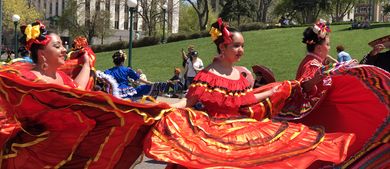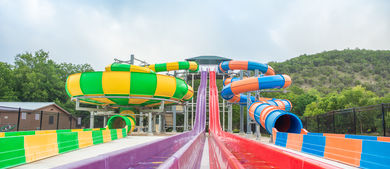While Albuquerque is famous for its annual International Balloon Fiesta, Oct. 1-9, that’s just one of many things to see and do in northern New Mexico in fall.

Trip Planning
Fall Travel in Northern New Mexico
Jeff Crider shares his travel tips for fall in northern New Mexico.

In fact, the Land of Enchantment offers RV enthusiasts numerous scenic, historic and cultural attractions, starting with Albuquerque itself. These include:
— The Sandia Peak Tramway which affords spectacular views of Albuquerque and surrounding areas. Some people hike the 7.5-mile La Luz Trail to the 10,378-foot summit of Sandia Peak, then ride the tram down.
— Old Town Albuquerque, a national historic site founded in 1706 that features over 150 boutique stores and restaurants and world-class museums.
— The Albuquerque Museum of Art and History, which features over 35,000 artifacts, including Native American textiles, Hispanic religious art and Route 66 memorabilia.
— The Indian Pueblo Cultural Center, which contains murals and other Native arts and artifacts, a library, archives, an education department, a teaching kitchen/restaurant, and cultural programming and events – each celebrating the Pueblo culture of New Mexico.
— Casa Flamenca, a nonprofit arts center dedicated to preserving the roots, artistry and soul of flamenco dancing. Since its founding in 2010, Casa Flamenca has produced original, world-class artists in the flamenco arts in addition to offering workshops and performances throughout the year.
Albuquerque area campgrounds include:
— Albuquerque KOA Journey in Albuquerque.
— American RV Resort in Albuquerque.
— Turquoise Trail Campground in Cedar Crest.

Acoma Pueblo
A little over an hour’s drive west of Albuquerque is the 1,000-year old Acoma Pueblo, one of the oldest continually occupied settlements in North America. Perched atop a 357-foot sandstone mesa, Acoma today is a tiny community with dirt streets and modest adobe homes. But Acoma is also a community with a remarkably well preserved Spanish mission-style church, San Estéban del Rey, and a fascinating history.
Built between 1629 and 1641, San Estéban del Rey is New Mexico’s oldest adobe church. Its roof is supported by one- and two-ton ponderosa logs, which the Acoma people were forced by the Spanish to carry 40 miles across the desert from 11,306-foot Mount Taylor, according to Acoma Pueblo guides.
The Acoma people put up fierce resistance to Spanish efforts to subdue their community, prompting the notoriously brutal Spanish explorer, Don Juan de Oñate, to send a war party to attack the isolated mountain community. According to historical accounts, Acoma surrendered after a three-day battle and the Spanish subsequently performed amputations on the feet of surviving Acoma men and forced them into slavery along with surviving females over the age of 12. While De Oñate is credited with founding several of New Mexico’s cities, including Santa Fe, his reputation for brutality against Native Americans ultimately resulted in him being banished from New Mexico.

Inscription Rock
Roughly another 75 minute drive west of Acoma is El Morro National Monument, where visitors can see Inscription Rock, a sandstone cliff that features ancient Native American petroglyphs as well as etchings by some of the first European explorers in North America. This includes an inscription by the brutal Spanish conquistador, Don Juan de Oñate, who etched his name in the sandstone rock in 1605, 15 years before the arrival of the pilgrims at Plymouth Rock.
Campgrounds near Acoma and El Morro National Monument include:
— Grants KOA Journey in Grants.
Chaco Canyon National Monument
RVers willing to travel on washboard roads will also be interested in exploring Chaco Culture National Historic Park in remote northwest New Mexico. The park features “the largest, best preserved, and most complex prehistoric architectural structures” in North America, according to the National Park Service. Chaco Canyon’s most visited structures include Pueblo Bonito, which includes remnants of a multistory “great house.”
While the largest structures in Chaco Canyon date back to the 800s, archaeologists have identified approximately 4,000 prehistoric and historic archaeological sites in the canyon that represent more than 10,000 years of human history. Chaco Canyon itself was an important ancient commercial center whose products included everything from turquoise mined in New Mexico to chocolate and exotic scarlet macaws that traders brought up to Chaco Canyon from Mexico and Central America.
Campgrounds in Chaco Canyon include Gallo Campground, which is just a few steps away from an ancient cliff dwelling.

Santa Fe
While Santa Fe is famous for its many art galleries, the city also has many historical sites, including the 412-year-old Palace of the Governors. Originally built in 1610, the building initially housed the the Spanish government in New Mexico. It was subsequently used by the Pueblo Indians as they fought against Spanish rule, and later by Mexico when the Southwestern U.S. was part of Mexico. In modern times the building has been used by the state of New Mexico.
Art enthusiasts who visit Santa Fe can enjoy over 300 art galleries, plus numerous art museums, such as the Georgia O’Keefe Museum, the New Mexico Museum of Art, the Museum of Indian Arts and Culture, and the Museum of International Folk Art. Georgia O’Keefe’s Ghost Ranch is about an hour’s drive to the north.

Nearby campgrounds include:
— Los Sueños de Santa Fe RV Resort and Campground in Santa Fe.
— Santa Fe Skies RV Park in Santa Fe.
— Trailer Ranch RV Resort in Santa Fe.
Taos
One of most memorable sites in Taos is the historic Taos Pueblo which, like Acoma, has been continuously occupied for a 1,000 years.
Taos Pueblo is the only living Native American community designated both a World Heritage Site by UNESCO and a National Historic Landmark. Its current buildings are believed to have been constructed between sometime between 1000 and 1450 A.D.
Visitors to Taos may also visit the homes of some of the leading figures in the westward expansion of the United States.
Kit Carson, the famed American frontiersman, soldier and Indian agent, lived in Taos for 25 years in a home he gave to his third wife, Maria Josefa Jaramillo, as a wedding present. The home is now a museum along with the home of New Mexico Territorial Governor Bent, which is also nearby. The Kit Carson House and Museum, built in 1825, was purchased by Kit Carson in 1843 as a wedding gift for his third wife, Josefa Jaramillo, a member of a prominent Taos family.
Nearby campgrounds include:
— Taos Valley RV Park in Taos.
— Taos RV Park in Taos.
Enchanted Circle
One of the most scenic drives in New Mexico in fall is the 84-mile Enchanted Circle Scenic Byway. The route starts in Taos and heads north past the turnoff to Taos Ski Valley, which is located in a pine and aspen filled canyon nearly 20 miles north of Taos itself.
Before embarking on the Enchanted Circle, many visitors take a short side trip to see the Rio Grande Gorge Bridge, which rises 565 feet above the Rio Grande River. Located 12 miles northwest of Taos, the Rio Grande Gorge Bridge is the fifth tallest bridge in the United States and the second highest on the U.S. highway system.
The Enchanted Circle itself leads travelers around 13,161-foot Wheeler Peak, New Mexico’s highest mountain. It also passes through the scenic mountain town of Red River before climbing Bobcat Pass at 9,820 feet, and descending again back toward Taos via the tiny town of Eagle Nest and close to the town of Angel Fire.
Campgrounds along or near the Enchanted Circle include:
— Sierra Hermosa RV Park in Questa.

— Roadrunner RV Resort in Red River, a forested campground with campsites close to Red River itself, which flows though the spacious campground.

Route 66 Attractions
No trip to northern New Mexico would be complete without exploring at least some of the museums that highlight the history of Route 66, one of America’s most famous highways.
Commissioned in 1926 and fully paved by the 1930s, Route 66 was the highway of choice for much of the 20th century for travelers making cross-country trips between Chicago and Los Angeles. Several interstate highways have since replaced the original Route 66, although much of the southern portion of original route is paralleled by Interstate 40, including its New Mexico section.
Route 66 attractions in New Mexico include the Route 66 Auto Museum in Santa Rosa, which features custom and classic cars and memorabilia, and the New Mexico Route 66 Museum in Tucumcari, which contains historic photos, memorabilia, a vintage diner display as well as gas pumps and porcelain signs. The museum’s collection also has several classic automobiles, including a 1929 Ford Model A Sedan, a 1931 Ford Model A Coupe, a 1937 Studebaker President, a 1956 Mercury Montclair, a 1963 Studebaker GT, and a 1975 Plymouth Fury.
Nearby campgrounds include:
— Blaze-in-Saddle RV Park in Tucumcari.
— Tucumcari / Route 66 KOA Journey in Tucumcari.












